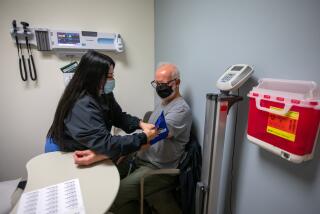Don’t Fear the Huge Changes in Health Care
Henry J. Kaiser, the wartime industrialist who 40 years ago devised a model hospital plan that many in U.S. health care are now following, liked to say that “problems are opportunities in work clothes.” But would even the irrepressible Kaiser be so optimistic if he had lived to see the American medical system today?
Here is a massive industry--$450 billion a year worth of hospitals, doctors, medicine and insurance, close to 11% of the gross national product--in seeming chaos. Medical costs continue to rise at a rate much faster than inflation, while roughly 40% of the nation’s 1-million-plus hospital beds lie empty. Doctors are caught between the risks of malpractice lawsuits--and the rising cost of insurance against them--and pressures from the federal government and private insurers to hold down the cost of treatment.
At least in some parts of the country we have too many hospitals, and even the American Medical Assn. concedes that there’s a glut of doctors. Yet we seem to lack facilities and staff for nursing homes. And medical care for the indigent is a growing problem because the system no longer provides an easy answer as to who will pay the cost.
Impact of Cost Control
What is happening? Cost control has come to medical care and is having an impact greater than that of deregulation in the airline and banking industries. The system suddenly is operating without a net. Rather than pay any Medicare bill that is handed to it, the federal government has said since 1983 that it will pay a specific fee for a specific treatment. Private insurers, spurred by the employers who buy group health plans for the work force, have imposed similar restrictions. Cost control, leading to shorter hospital stays, is the reason all those beds lie empty.
The restrictions are now beginning to bite; growth in the cost of hospital care will slow from 13% a year to between 5% and 6% next year, in the estimate of analyst Kenneth Abramowitz of the Sanford C. Bernstein & Co. investment firm, and to 1% a year by 1990. Abramowitz expects 10% of the nation’s hospitals to be forced into bankruptcy in the next two years.
What would Kaiser say to that? Opportunity as usual, without a doubt. As he did in 1942, when he set up the Permanente Foundation to provide prepaid, fixed-fee medical care for his shipyard and steel mill workers, Kaiser would see today’s medical problems as essentially ones of business: how to provide the best service at the lowest cost. And he’d be rolling up his sleeves to get to work.
Package Deals for Employers
These days he would not be alone. For-profit hospital companies, such as Humana Inc. and Hospital Corp. of America, and fixed-fee health maintenance organizations, such as U.S. Health Care Systems and Maxicare Health Plans, are offering employers finance and medical care package deals in competing with the insurance companies for group health business.
The big insurers are not sleeping. Aetna Life & Casualty launched a joint venture Tuesday with 550 hospitals in 45 states belonging to the Dallas-based Voluntary Hospitals of America group. Under the plan, Aetna will allow greater benefits and lower deductibles to employees using VHA facilities.
What are they all competing for? For patients to fill the oversupply of hospital beds, to occupy the oversupply of doctors. Competition will intensify, mergers and consolidations--like the restructuring National Medical Enterprises announced this week--will reshape the field. Joseph Boystak, who is setting up a health-care investment banking group for Los Angeles’ Security Pacific National Bank, points out that new ways of financing will be needed as traditional hospital bonds become riskier.
Where is all this leading? To a health-care industry in the 1990s dominated by large national companies offering a service integrated from insurance plan to stethoscope. There will be local variations, but the trend is clear.
Just as clearly, there will be a backlash. Powerful people will be dislocated by medicine’s industrialization. Doctors’ incomes, adjusted for inflation, are already falling. There will be cries for government intervention, for a return to old ways. But industrialization, an overdue response to runaway costs, will be hard to stop.
It is not to be feared. In one sense, all we are really talking about is a salaried group medical practice, and that is a concept originated 100 years ago in Rochester, Minn., by the surgeon brothers William and Charles Mayo, whose work led to the world-renowned Mayo Clinic.
Yes, the new medical economics must prove able to finance health care for the poor--something that the slack in the old system at least paid for. And ways should be found to encourage preventive medicine--which keeps people out of hospitals. Whether those problems turn out to be what Henry J. Kaiser called opportunities in overalls remains to be seen.
More to Read
Inside the business of entertainment
The Wide Shot brings you news, analysis and insights on everything from streaming wars to production — and what it all means for the future.
You may occasionally receive promotional content from the Los Angeles Times.









